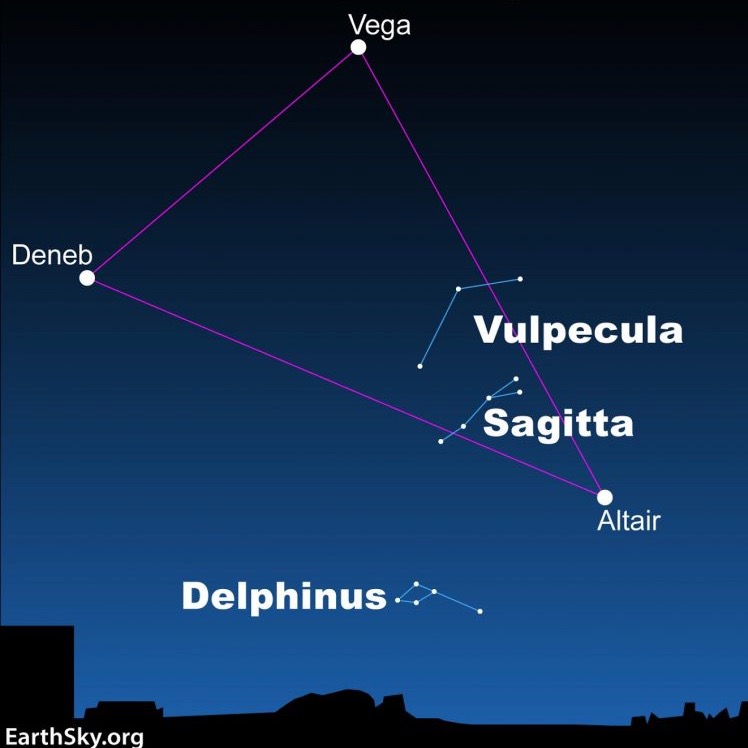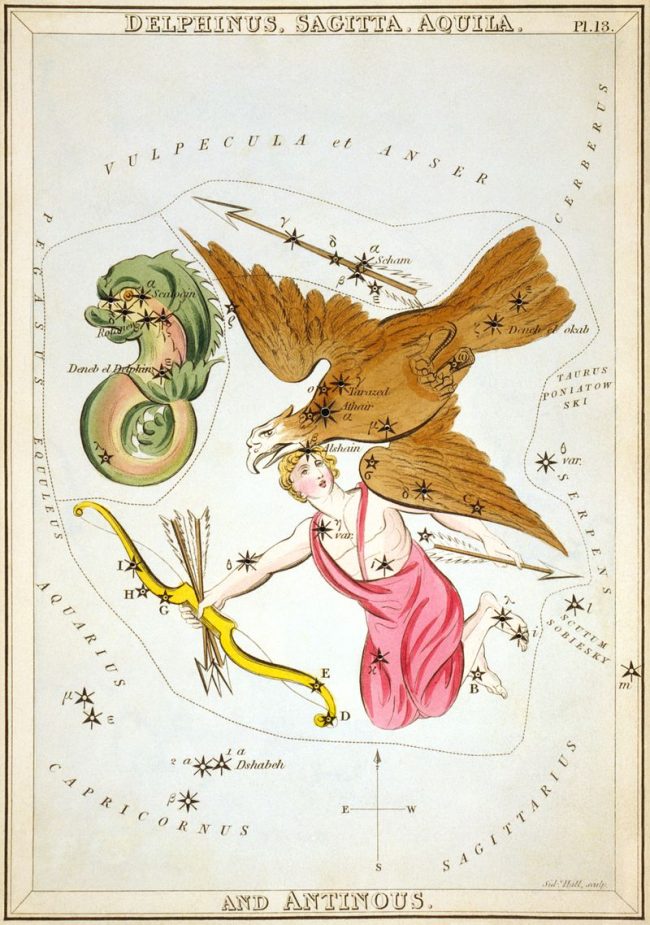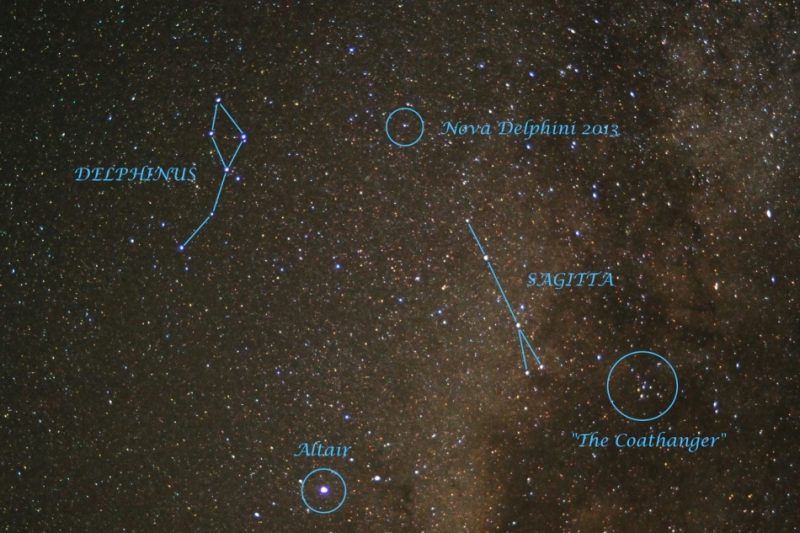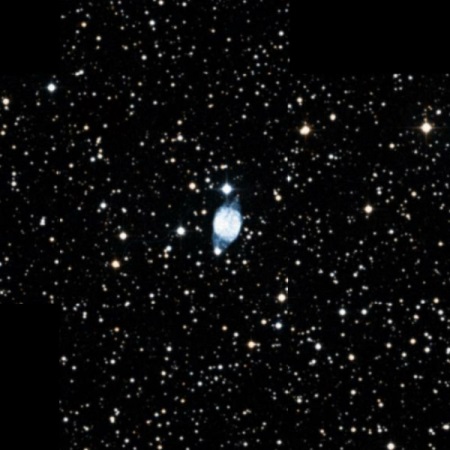
How to see Delphinus
Delphinus the Dolphin is the 69th-smallest of the 88 constellations. It comes into view each year on northern summer evenings. By northern fall, it’s well placed for viewing, arcing high across the sky each night. Its stars are faint. To see it, you’ll want a dark sky.
Delphinus lies just outside of the line connecting the stars Deneb in Cygnus and Altair in Aquila. These bright stars form two corners of the famous Summer Triangle asterism. Scan along that line with your eye or binoculars. If your sky is dark enough, Delphinus will pop into view.
Delphinus looks very much like the animal it’s supposed to represent. Its faint stars form a kite shape with a tail. The little dolphin appears to leap out of the dark waters of the night sky.

Delphinus in history and mythology
The name Delphinus means dolphin in Latin. But it was a Greek astronomer – Ptolemy of Alexandria in the second century CE – who first cataloged these stars. In Greek mythology, Delphinus represents the dolphin sent by the sea god Poseidon to fetch Amphitrite, a goddess of the sea and one of the fabled Nereids. It’s said Poseidon chose Amphitrite from among her sisters as they performed a dance on the isle of Naxos. The dolphin carried Amphitrite to Poseidon, and she became his wife. He rewarded the dolphin by making it a constellation.
In another story, Delphinus saves the Greek poet Arion when he is attacked by robbers on a ship. They were about to kill Arion, but he begged permission to sing a final song. His captors agreed, and the poet stood on the deck of the ship and sang a dirge accompanied by his lyre. He then threw himself overboard. A dolphin who’d heard his song and been charmed by the music saved him.

The stars of the Dolphin
The brightest star in the Dolphin is Beta Delphini, which shines at magnitude 3.6. The star also goes by the name Rotanev. Lying 97 light-years from Earth, it marks the point in the constellation where the Dolphin’s body connects with its tail.
The second brightest star is Alpha Delphini, at magnitude 3.7. This star nickname is Sualocin. Lying 240 light-years away, it marks the back of the Dolphin.
These two stars’ common names, Rotanev and Sualocin, are part of a puzzle. Italian astronomer Nicolaus Venator named these two stars. Can you solve the puzzle? Hint: try reading the stars’ names backward.
The nose of Delphinus is Gamma Delphini, a double star. The pair of stars shine at magnitude 4.2 and 5.1. They lie approximately 102 light-years away. The belly of the dolphin is Delta Delphini, a magnitude-4.4 star lying 203 light-years away.
Although Delphinus is a small constellation, it contains an asterism: Job’s Coffin. The four stars that mark the body of the Dolphin are the same stars that form Job’s Coffin.
The tail of the dolphin contains one star, Epsilon Delphini or Aldulfin. The magnitude-4.0 star lies 359 light-years away.
In 2013, a bright nova exploded in Delphinus not far from Sualocin. The nova, V339 Delphini, was temporarily visible to the unaided eye.

Deep-sky objects
Most of the deep-sky objects in Delphinus are quite dim. The brightest of these is a globular cluster, NGC 6934, found about 4 degrees out from the tail. NGC 6934 shines at magnitude 8.9. Another globular cluster, NGC 7006, lies off the nose of the Dolphin. If you draw a line from Sualocin through the nose star Gamma and extend it for about twice that distance, you’ll reach NGC 7006. NGC 7006 shines at magnitude 10.6.
Two planetary nebulae lie within the northwestern boundary of the constellation. Both are 12th magnitude. NGC 6905 – the Blue Flash Nebula – lies directly above the Dolphin’s back. The other planetary nebula – NGC 6891 – is above Delphinus’s tail. A number of galaxies are scattered about Delphinus; however, most of them are 12th magnitude and dimmer, making them very hard to spot without a large telescope.

News from Delphinus the Dolphin
In 2021, scientists announced they’d pinpointed the origin of a neutrino, or high-energy particle. And it came from the direction of Delphinus the Dolphin. They believe that, in a cataclysmic event, a supermassive black hole and a star drew too close together. The black hole shredded the star, which released the cosmic ray neutrino. Scientists detected the neutrino using the IceCube Neutrino Observatory at the Amundsen-Scott South Pole Station in Antarctica. So much info from such a tiny particle! Read more about the discovery.
Bottom line: Delphinus the Dolphin is a petite constellation that looks like the animal it’s supposed to represent. Look for the dolphin leaping under the Summer Triangle.
The post Delphinus the Dolphin resembles its name first appeared on EarthSky.
from EarthSky https://ift.tt/3lyAnHv

How to see Delphinus
Delphinus the Dolphin is the 69th-smallest of the 88 constellations. It comes into view each year on northern summer evenings. By northern fall, it’s well placed for viewing, arcing high across the sky each night. Its stars are faint. To see it, you’ll want a dark sky.
Delphinus lies just outside of the line connecting the stars Deneb in Cygnus and Altair in Aquila. These bright stars form two corners of the famous Summer Triangle asterism. Scan along that line with your eye or binoculars. If your sky is dark enough, Delphinus will pop into view.
Delphinus looks very much like the animal it’s supposed to represent. Its faint stars form a kite shape with a tail. The little dolphin appears to leap out of the dark waters of the night sky.

Delphinus in history and mythology
The name Delphinus means dolphin in Latin. But it was a Greek astronomer – Ptolemy of Alexandria in the second century CE – who first cataloged these stars. In Greek mythology, Delphinus represents the dolphin sent by the sea god Poseidon to fetch Amphitrite, a goddess of the sea and one of the fabled Nereids. It’s said Poseidon chose Amphitrite from among her sisters as they performed a dance on the isle of Naxos. The dolphin carried Amphitrite to Poseidon, and she became his wife. He rewarded the dolphin by making it a constellation.
In another story, Delphinus saves the Greek poet Arion when he is attacked by robbers on a ship. They were about to kill Arion, but he begged permission to sing a final song. His captors agreed, and the poet stood on the deck of the ship and sang a dirge accompanied by his lyre. He then threw himself overboard. A dolphin who’d heard his song and been charmed by the music saved him.

The stars of the Dolphin
The brightest star in the Dolphin is Beta Delphini, which shines at magnitude 3.6. The star also goes by the name Rotanev. Lying 97 light-years from Earth, it marks the point in the constellation where the Dolphin’s body connects with its tail.
The second brightest star is Alpha Delphini, at magnitude 3.7. This star nickname is Sualocin. Lying 240 light-years away, it marks the back of the Dolphin.
These two stars’ common names, Rotanev and Sualocin, are part of a puzzle. Italian astronomer Nicolaus Venator named these two stars. Can you solve the puzzle? Hint: try reading the stars’ names backward.
The nose of Delphinus is Gamma Delphini, a double star. The pair of stars shine at magnitude 4.2 and 5.1. They lie approximately 102 light-years away. The belly of the dolphin is Delta Delphini, a magnitude-4.4 star lying 203 light-years away.
Although Delphinus is a small constellation, it contains an asterism: Job’s Coffin. The four stars that mark the body of the Dolphin are the same stars that form Job’s Coffin.
The tail of the dolphin contains one star, Epsilon Delphini or Aldulfin. The magnitude-4.0 star lies 359 light-years away.
In 2013, a bright nova exploded in Delphinus not far from Sualocin. The nova, V339 Delphini, was temporarily visible to the unaided eye.

Deep-sky objects
Most of the deep-sky objects in Delphinus are quite dim. The brightest of these is a globular cluster, NGC 6934, found about 4 degrees out from the tail. NGC 6934 shines at magnitude 8.9. Another globular cluster, NGC 7006, lies off the nose of the Dolphin. If you draw a line from Sualocin through the nose star Gamma and extend it for about twice that distance, you’ll reach NGC 7006. NGC 7006 shines at magnitude 10.6.
Two planetary nebulae lie within the northwestern boundary of the constellation. Both are 12th magnitude. NGC 6905 – the Blue Flash Nebula – lies directly above the Dolphin’s back. The other planetary nebula – NGC 6891 – is above Delphinus’s tail. A number of galaxies are scattered about Delphinus; however, most of them are 12th magnitude and dimmer, making them very hard to spot without a large telescope.

News from Delphinus the Dolphin
In 2021, scientists announced they’d pinpointed the origin of a neutrino, or high-energy particle. And it came from the direction of Delphinus the Dolphin. They believe that, in a cataclysmic event, a supermassive black hole and a star drew too close together. The black hole shredded the star, which released the cosmic ray neutrino. Scientists detected the neutrino using the IceCube Neutrino Observatory at the Amundsen-Scott South Pole Station in Antarctica. So much info from such a tiny particle! Read more about the discovery.
Bottom line: Delphinus the Dolphin is a petite constellation that looks like the animal it’s supposed to represent. Look for the dolphin leaping under the Summer Triangle.
The post Delphinus the Dolphin resembles its name first appeared on EarthSky.
from EarthSky https://ift.tt/3lyAnHv

Aucun commentaire:
Enregistrer un commentaire